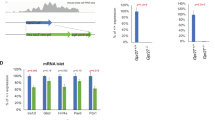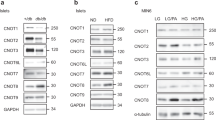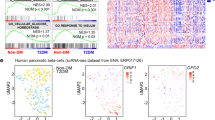Abstract
Type 2 diabetes mellitus is a widespread disease, affecting millions of people globally. Although genetics and environmental factors seem to have a role, the cause of this metabolic disorder is largely unknown. Here we report a genetic flaw that markedly reduced the intracellular expression of the high mobility group A1 (HMGA1) protein, and adversely affected insulin receptor expression in cells and tissues from four subjects with insulin resistance and type 2 diabetes. Restoration of HMGA1 protein expression in subjects' cells enhanced INSR gene transcription, and restored cell-surface insulin receptor protein expression and insulin-binding capacity. Loss of Hmga1 expression, induced in mice by disrupting the Hmga1 gene, considerably decreased insulin receptor expression in the major targets of insulin action, largely impaired insulin signaling and severely reduced insulin secretion, causing a phenotype characteristic of human type 2 diabetes.
This is a preview of subscription content, access via your institution
Access options
Subscribe to this journal
Receive 12 print issues and online access
$209.00 per year
only $17.42 per issue
Buy this article
- Purchase on Springer Link
- Instant access to full article PDF
Prices may be subject to local taxes which are calculated during checkout





Similar content being viewed by others
References
Kahn, C.R. Insulin action, diabetogenes, and the cause of type II diabetes (Banting Lecture). Diabetes 43, 1066–1084 (1994).
Polonsky, K.S., Sturis, J. & Bell G.I. Non-insulin-dependent diabetes mellitus – a genetically programmed failure of the beta cell to compensate for insulin resistance. N. Engl. J. Med. 334, 777–783 (1996).
Taylor, S.I. Insulin resistance or insulin deficiency: which is the primary cause of NIDDM? Diabetes 43, 735–740 (1994).
Goldfine, I.D. The insulin receptor: molecular biology and transmembrane signalling. Endocr. Rev. 8, 235–255 (1987).
Taylor, S.I. et al. Mutations in the insulin receptor gene. Endocr. Rev. 13, 566–595 (1992).
Bustin, M. Regulation of DNA-dependent activities by the functional motifs of the high-mobility-group chromosomal proteins. Mol. Cell. Biol. 19, 5237–5246 (1999).
Reeves, R., Beckerbauer, L. HMGI/Y proteins: flexible regulators of transcription and chromatin structure. Biochim. Biophys. Acta. 1519, 13–29 (2001).
Thanos, D., & Maniatis, T. The high mobility group protein HMG I(Y) is required for NF-kB-dependent virus induction of the human IFN-β gene. Cell 71, 777–789 (1992).
Brunetti, A., Manfioletti, G., Chiefari, E., Goldfine, I.D. & Foti, D. Transcriptional regulation of human insulin receptor gene by the high-mobility-group protein HMGI-Y. FASEB J. 15, 492–500 (2001).
Foti, D., Iuliano, R., Chiefari, E. & Brunetti, A. A nucleoprotein complex containing Sp1, C/EBPβ, and HMGI-Y controls human insulin receptor gene transcription. Mol. Cell. Biol. 23, 2720–2732 (2003).
Brunetti, A., Brunetti, L., Foti, D., Accili, D. & Goldfine, I.D. Human diabetes associated with defects in regulatory proteins for the insulin receptor gene. J.Clin. Invest. 97, 258–262 (1996).
Holth, L.T., Thorlacius, A.E. & Reeves, R. Effect of epidermal growth factor and estrogen on the regulation of the HMGI/Y gene in human mammary epithelial cell lines. DNA Cell Biol. 16, 1299–1309 (1997).
Borrmann, L., Wilkening, S. & Bullerdiek, J. The expression of HMGA genes is regulated by their 3'UTR. Oncogene 20, 4537–4541 (2001).
Kahn, C.R. et al. The syndromes of insulin resistance and acanthosis nigricans. N. Engl. J. Med. 294, 739–745 (1976).
Fidanza, V. et al. Double knockout of the ALL-1 gene blocks hematopoietic differentiation in vitro. Cancer. Res. 56, 1179–1183 (1996).
White, M.F. The IRS-signalling system: a network of docking proteins that mediate insulin action. Mol. Cell. Biochem. 182, 3–11 (1998).
Saltiel, A.R. & Pessin, J.E. Insulin signaling pathways in time and space. Trends Cell Biol. 12, 65–71 (2002).
Cho, H. et al. Insulin resistance and a diabetes mellitus-like syndrome in mice lacking the protein kinase Akt2 (PKBβ). Science 292, 1728–1731 (2001).
Bruning, J.C. et al. Development of a novel polygenic model of NIDDM in mice heterozygous for IR and IRS-1 null alleles. Cell 88, 561–572 (1997).
Kulkarni, R.N. et al. Tissue-specific knockout of the insulin receptor in pancreatic β cells creates an insulin secretory defect similar to that in type 2 diabetes. Cell 96, 329–339 (1999).
Kitamura, T., Kahn, C.R. & Accili, D. Insulin receptor knockout mice. Annu. Rev. Physiol. 65, 313–332 (2003).
Shimomura, I. et al. Decreased IRS-2 and increased SREBP-1c lead to mixed insulin resistance and sensitivity in livers of lipodystrophic and ob/ob mice. Mol. Cell. 6, 77–86 (2000).
Rane, S.G. et al. Loss of Cdk4 expression causes insulin-deficient diabetes and Cdk4 activation results in β-islet cell hyperplasia. Nat. Genet. 22, 44–52 (1999).
Belke, D.D., Larsen, T.S., Gibbs, E.M., & Severson, D.L. Glucose metabolism in perfused mouse hearts overexpressing human GLUT-4 glucose transporter. Am. J. Physiol. Endocrinol. Metab. 280, E420–E427 (2001).
Bilan, P.J., Ramlal, T., & Klip, A. IGF-1 mediated recruitment of glucose transporters from intracellular membranes to plasma membranes in L6 muscle cells. Adv. Exp. Med. Biol. 293, 273–288 (1991).
Weiland, M. et al. The signaling potential of the receptors for insulin and insulin-like growth factor I (IGF-I) in 3T3-L1 adipocytes: comparison of glucose transport activity, induction of oncogene c-fos, glucose transporter mRNA, and DNA-synthesis. J. Cell. Physiol. 149, 428–435 (1991).
Sandhu, M.S. et al. Circulating concentrations of insulin-like growth factor-I and development of glucose intolerance: a prospective observational study. Lancet. 359, 1740–1745 (2002).
Allander, S.V. et al. Hepatic nuclear factor 3 and high mobility group I/Y proteins bind the insulin response element of the insulin-like growth factor-binding protein-1 promoter. Endocrinology. 138, 4291–4300 (1997).
Di Cola, G., Cool, M.H., & Accili, D. Hypoglycemic effect of insulin-like growth factor-1 in mice lacking insulin receptors. J. Clin. Invest. 99, 2538–2544 (1997).
Ohneda, K., Mirmira, R.G., Wang, J., Johnson, J.D. & German, M.S. The homeodomain of PDX-1 mediates multiple protein-protein interactions in the formation of a transcriptional activation complex on the insulin promoter. Mol. Cell. Biol. 20, 900–911 (2000).
Taylor, S.I. Deconstructing type 2 diabetes. Cell 97, 9–12 (1999).
Kim, S.K., & Hebrok, M. Intercellular signals regulating pancreas development and function. Genes & Dev. 15, 111–127 (2001).
Eizirik, D.L. et al. Major species differences between humans and rodents in the susceptibility to pancreatic β-cell injury. Proc. Natl. Acad. Sci. USA. 91, 9253–9256 (1994).
Acknowledgements
We are grateful to L. Levintow for critical reading of the manuscript, and N. Perrotti for helpful discussion. We thank T. Maniatis, D. Thanos and J. Bullerdiek for providing plasmids; V. Orlando and P. Malatesta for advice on ChIP and FISH, respectively; G. Donato for pancreatic histology studies; C. Capula for referring patients with insulin resistance. Also, we thank the Laboratorio di Diagnosi PrePostnatale Malattie Metaboliche (Istituto G. Gaslini) for the service of the “Cell line and DNA bank from patients affected by genetic disease”. We are indebted to A. Luciano and the staff of the Animal Facility for animal care. This work was supported by Telethon-Italy, grants E613 and GGP04245, and MIUR, protocols 2002062899-002 and 2004062059-002 Italy to A.B.We dedicate this article to the memory of Pope John Paul II, who said, “Science can purify religion from error and superstition. Religion can purify science from idolatry and false absolutes.”
Author information
Authors and Affiliations
Corresponding author
Ethics declarations
Competing interests
The authors declare no competing financial interests.
Supplementary information
Rights and permissions
About this article
Cite this article
Foti, D., Chiefari, E., Fedele, M. et al. Lack of the architectural factor HMGA1 causes insulin resistance and diabetes in humans and mice. Nat Med 11, 765–773 (2005). https://doi.org/10.1038/nm1254
Received:
Accepted:
Published:
Issue Date:
DOI: https://doi.org/10.1038/nm1254
This article is cited by
-
Progress and application of adipose-derived stem cells in the treatment of diabetes and its complications
Stem Cell Research & Therapy (2024)
-
Molecular signature of excessive female aggression: study of stressed mice with genetic inactivation of neuronal serotonin synthesis
Journal of Neural Transmission (2023)
-
MicroRNA-24-3p promotes skeletal muscle differentiation and regeneration by regulating HMGA1
Cellular and Molecular Life Sciences (2022)
-
A haplotype-resolved genome assembly of the Nile rat facilitates exploration of the genetic basis of diabetes
BMC Biology (2022)
-
Interplay between HMGA and TP53 in cell cycle control along tumor progression
Cellular and Molecular Life Sciences (2021)



